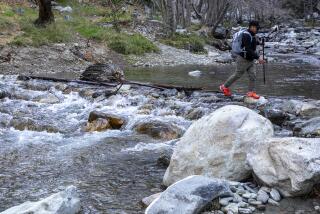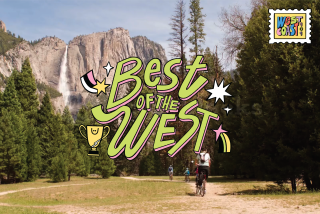Fort Bragg: You can go home again
- Share via
Reporting from Fort Bragg, Calif. — Fifteen years ago, the century-old redwood train trestle at the north end of Fort Bragg, on the Mendocino coast, was where teenagers went to smoke cigarettes and make out. The towering bridge — gorgeous even at the height of its decay — was closed to pedestrians because of rotting beams and gaping holes. But the view, high above Pudding Creek and out over the churning Pacific, was irresistible for romance and rebellion, the wire fence at the bridge’s mouth a feeble barrier against young, bored Fort Braggers. I know. I was one of them.
Last year I returned to my hometown and found that old trestle transformed into a grand pedestrian bridge, a stately lattice of weathered redwood beams connecting two sets of rocky bluffs. Families glided across on bicycles, mothers pushed infants in strollers and couples held hands at sunset.
Other things about Fort Bragg had changed.
This once-gritty logging and fishing town, 170 miles north of San Francisco, had softened. Since its sprawling oceanfront mill closed in 2002, the town’s coastline — previously obscured by chugging smokestacks, two-story-high mounds of timber and hulking warehouses — had been cleared. Driving north on Highway 1, I looked out across the 415-acre mill site, now mostly open meadows and wind-gnarled trees, and glimpsed the Pacific.
For the first time, I saw Fort Bragg as a passerby would — as a tourist in my hometown. To my surprise, I liked what I saw.
The town of my childhood, perpetually in the shadow of Mendocino, the Disney-esque Victorian village to the south, still has rough edges: The formerly frenetic Noyo Harbor looks like the final resting place for California’s fishing industry. Downtown’s bars are relics of 1950s-era Fort Bragg, with their worn shuffleboard tables and Patsy Cline jukeboxes. (Until recently, my favorite dive, the Golden West, was run by a husband-and-wife duo that defied the state smoking ban well into this century.)
There are some vacant storefronts, some trailer homes, some oversized pickups and plenty of chipped paint. There is even a handful of chain restaurants, the kind that Mendocino’s historical review board would never allow.
Fort Bragg isn’t a showpiece. It’s not flawless or quaint. It’s ridden with unkempt Western history but relatively free of kitschy souvenir shops and commemorative plaques. For those who have an appreciation for places that feel lived in — that feel like somebody’s hometown — Fort Bragg’s authenticity is part of its appeal.
The other, more obvious part comes in the form of unhurried bike rides, long lunches, an illustrious local brewery and an abundance of places to let sand run between one’s toes. In other words, Fort Bragg is an easy, lazy, unpretentious beach town.
One recent afternoon, my husband, Tim, and I drove to Ward Avenue, 41/2 miles north of Fort Bragg, where the Old Haul Road — a paved coastal trail that was once the rail route that transported timber to Fort Bragg’s mill — crumbles into the shoreline at Inglenook Fen-Ten Mile Dunes Preserve. From there, we could have walked north past where the pavement ends and had miles of sand and sky to ourselves.
But we were in the mood for something else.
We climbed on our bikes and rode south through MacKerricher State Park. The trip took us past expanses of beach, with patches roped off for breeding sea lions and their clumsy cubs, past rocky outcroppings carpeted with mussels, anemones and sea palms, past the cattail-wrapped Lake Cleone, past the surfers at Virgin Creek Beach and across the newly improved Pudding Creek Trestle.
We cruised into town, taking back streets past an eclectic mix of Craftsman-style bungalows and Victorian homes, each as delicate as a wedding cake. We cruised by the North Coast Brewing Co., which periodically fills Fort Bragg’s air with the sweet stink of boiling malt. We passed the old train depot that now serves the Skunk Train, a novelty rail line that travels 40 miles inland, through the redwoods, to the neighboring town of Willits.
Downtown, we shared a Reuben Dog piled with sauerkraut and Swiss cheese at Relish, Fort Bragg’s attempt at the gourmet hot dog stand, instead of going with our usual — a thin-crust pie at Piaci Pub & Pizzeria. At Golden West, we swilled North Coast’s Blue Star over a game of shuffleboard. Riding home, we fought the strenuous breeze that had picked up as we whiled away our afternoon over hot dogs and beer and bar games.
By the time we made it back to our car, my legs burned and I was breathless. It was a ride I’d made probably 100 times before, but it looked new through adult eyes, like a stretch of coastline I was seeing for the first time.
A few weeks later, we met friends for the opening of a new bar inside what was once the mill’s company store. The building, a grand redwood warehouse with three-story ceilings and imposing beams, had been Fort Bragg’s sole department store throughout my childhood — the place where I was taken, year after year, for the annual rite of back-to-school shopping.
Today, the Company Store, as this upscale mini-mall has been renamed, houses an excellent Mendo Bistro, spa, a gallery, a coffeehouse, a bike shop and Living Lights, a well-known raw foods cooking school. There’s also the new Company Bar, where leather couches, nail-polish-red cabinets, an ornate dungeon-like wine cellar and extravagant cocktails compete with the pinball machines, vinyl stools, sticky floors and neon beer signs around the corner at the Golden West.
Like any place where the past and future mingle in such fragile kinship, the balance Fort Bragg has struck often feels impossible to maintain. But it’s a line my hometown seems determined to walk.
—
More to Read
Sign up for The Wild
We’ll help you find the best places to hike, bike and run, as well as the perfect silent spots for meditation and yoga.
You may occasionally receive promotional content from the Los Angeles Times.






